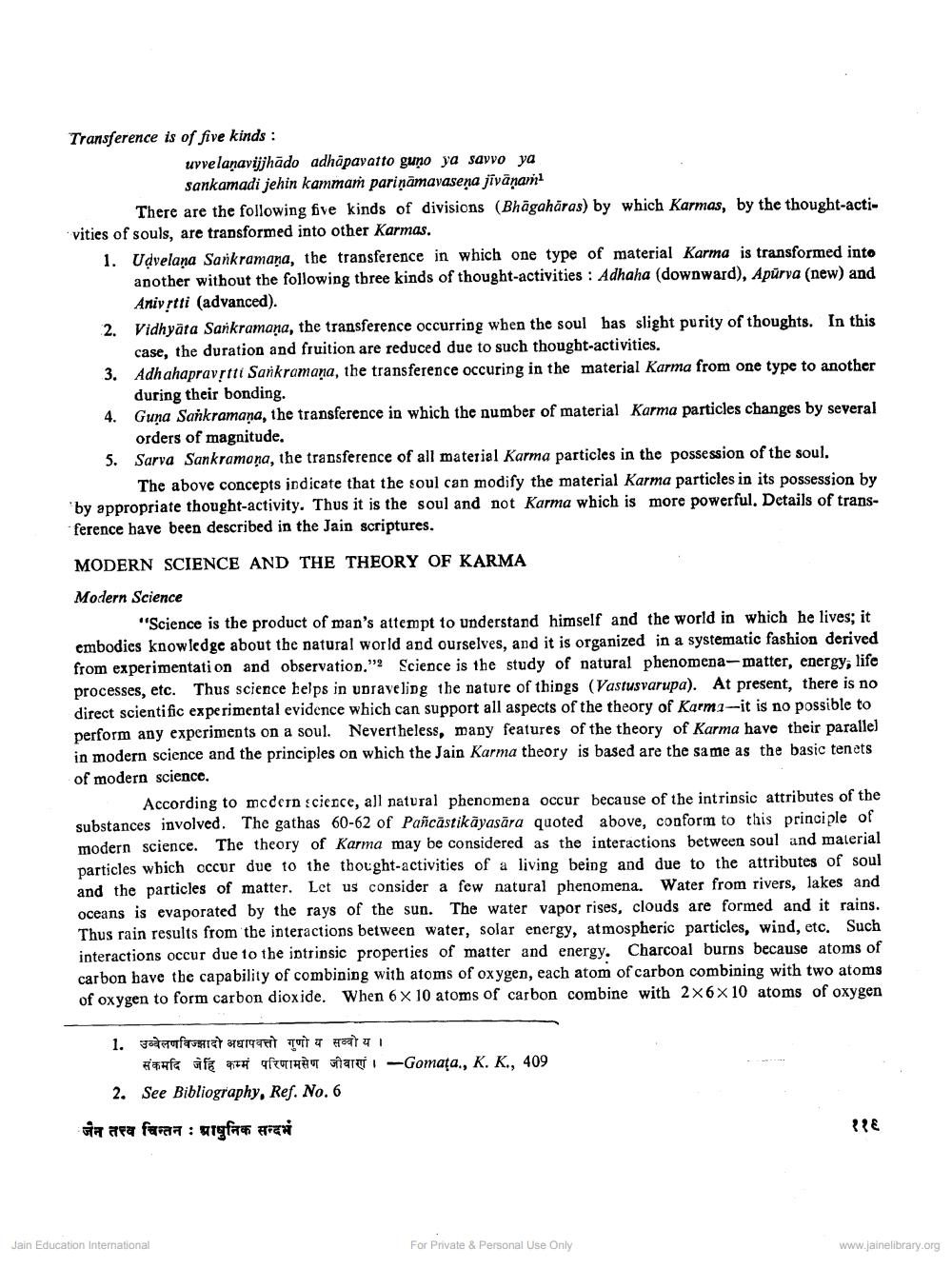Book Title: How Karma theory relates to Modern Science Author(s): Dulichand Jain Publisher: Z_Deshbhushanji_Maharaj_Abhinandan_Granth_012045.pdf View full book textPage 8
________________ Transference is of five kinds : uvvelanavijjhādo adhāpavatto gumo ya savvo ya sankamadi jehin kammaṁ pariņāmavasena jīvānami There are the following five kinds of divisions (Bhagahāras) by which Karmas, by the thought-activities of souls, are transformed into other Karmas. 1. Udvelana Sarikramana, the transference in which one type of material Karma is transformed into another without the following three kinds of thought-activities : Adhaha (downward), Apūrva (new) and Anivịtti (advanced). Vidhyāta Sankramana, the transference occurring when the soul bas slight purity of thoughts. In this case, the duration and fruition are reduced due to such thought-activities. 3. Adhahapravrtti Sankramaņa, the transference occuring in the material Karma from one type to another during their bonding. 4. Guna Sankramana, the transference in which the number of material Karma particles changes by several orders of magnitude. 5. Sarva Sankramona, the transference of all material Karma particles in the possession of the soul. The above concepts jpdicate that the soul can modify the material Karma particles in its possession by by appropriate thought-activity. Thus it is the soul and not Karma which is more powerful. Details of transference have been described in the Jain scriptures. MODERN SCIENCE AND THE THEORY OF KARMA Modern Science "Science is the product of man's attempt to understand himself and the world in which he lives; it embodies knowledge about the natural world and ourselves, and it is organized in a systematic fashion derived from experimentation and observation." Science is the study of natural phenomena-matter, energy, life processes, etc. Thus science helps in upraveling the nature of things (Vastusvarupa). At present, there is no direct scientific experimental evidence which can support all aspects of the theory of Karma-it is no possible to perform any experiments on a soul. Nevertheless, many features of the theory of Karma have their parallel in modern science and the principles on which the Jain Karma theory is based are the same as the basic tenets of modern science, According to modern science, all natural phenomena occur because of the intrinsic attributes of the substances involved. The gathas 60-62 of Pañcastikāyasāra quoted above, conform to this principle of modern science. The theory of Karma may be considered as the interactions between soul and material particles which occur due to the thought-activities of a living being and due to the attributes of soul and the particles of matter. Let us consider a few natural phenomena. Water from rivers, lakes and oceans is evaporated by the rays of the sun. The water vapor rises, clouds are formed and it rains. Thus rain results from the interactions between water, solar energy, atmospheric particles, wind, etc. Such interactions occur due to the intrinsic properties of matter and energy. Charcoal burns because atoms of carbon have the capability of combining with atoms of oxygen, each atom of carbon combining with two atoms of oxygen to form carbon dioxide. When 6 X 10 atoms of carbon combine with 2x6x 10 atoms of oxygen 1. zoo 01998 TUTT I **faf H ETHÈT ATTI --Gomata., K. K., 409 2. See Bibliography, Ref. No. 6 जैन तत्व चिन्तन : प्राधुनिक सन्दर्भ € Jain Education International For Private & Personal Use Only www.jainelibrary.orgPage Navigation
1 ... 6 7 8 9 10 11
